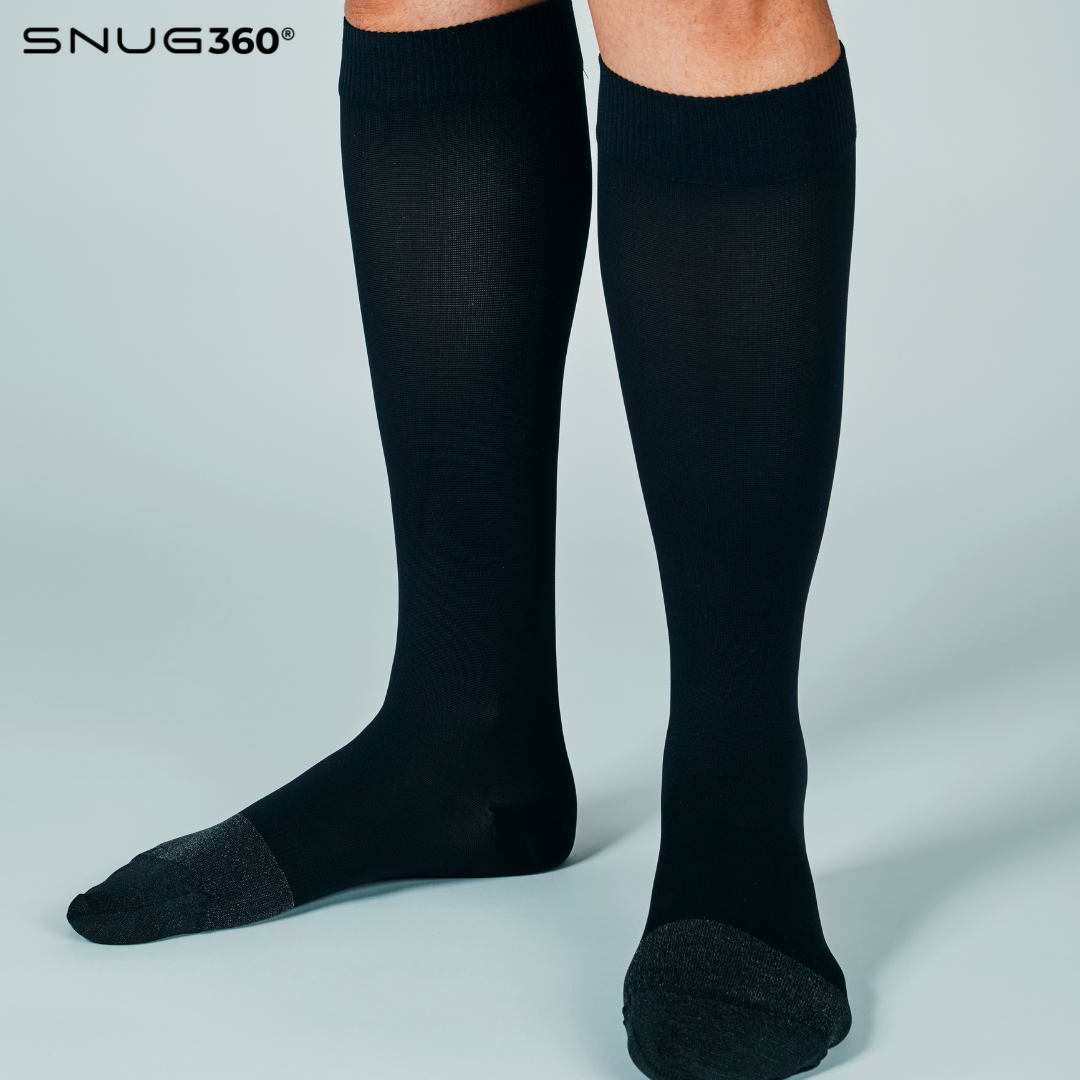Traveling by air can turn out to be an exciting adventure for leisure or business purposes. But long hours sitting in cramped airline seats can leave your body exhausted, sore, and swollen upon arrival. Also, the best compression socks for air travel offer an easy way to alleviate these discomforts and make the journey more pleasurable!
This blog post will majorly examine the benefits of wearing compression socks during air travel. From improving blood circulation to decreasing the risk of Deep Vein Thrombosis (DVT), compression socks offer many advantages that can make flying simpler.
Understanding Compression Socks
Before we delve into the perks of compression socks during air travel, let's first understand what they are and how they function. Compression socks are specially designed items that apply gentle pressure to legs, ankles, and feet to increase blood flow and reduce swelling, making them particularly beneficial during long sitting or standing sessions.
Compression socks work by applying graduated pressure, meaning they tighten tighter at the ankle and gradually loosen as you progress up the leg. This encourages blood to flow on the way to the heart instead of pooling in the lower extremities, helping circulation more efficiently. Furthermore, compression socks may even reduce major vein diameters in the legs to promote better blood flow.
A range of compression socks is on the market today, from mild to firm compression levels. Your selection will majorly depend on your personal needs and preferences; to make the right decision, it is advisable to consult a professional healthcare provider if in doubt.
Compression Socks Are Beneficial in Air Travel
Now that we understand how compression socks function let's delve deeper into their benefits for air travel:
Improved Blood Circulation
One of the primary advantages of wearing compression socks during air travel is improving blood circulation. Sitting for extended periods in enclosed environments can reduce blood flow to the legs, leading to discomfort and increasing risks such as Deep Vein Thrombosis (DVT). Compression socks help combat this by applying external pressure that encourages veins to pump back blood toward their hearts, preventing stagnation and encouraging better circulation.
Flights often leave passengers sitting, leading to blood accumulating in the lower extremities - particularly around calf muscles - which may result in discomfort, swelling, and blood clot formation. Compression socks may help alleviate such concerns by encouraging proper blood flow and decreasing risks of blood clot formation.
These graduated compression socks feature tightening around the ankle and gradually loosening as you progress up the leg to help return blood toward its source and prevent pooling in veins. This design supports optimal blood flow back towards your heart and ensures no one pools blood in their veins.
Reduced Risk of Deep Vein Thrombosis (DVT)
Deep Vein Thrombosis (DVT) is a potentially serious condition in which blood clots form, usually in deep veins in the legs, typically during long-duration air travel. Extensive periods of immobility, like sitting for too long on airplane seats, increase your risk for DVT. Compression socks help mitigate that risk by encouraging blood flow to circulate more smoothly through veins, thereby decreasing the pooling of blood in veins, thereby decreasing the chances of clot formation and thus lessening chances for DVT occurring.
DVT can have serious repercussions if left untreated, including the possibility of the blood clot breaking loose and traveling directly to your lungs and creating an embolism (pulmonary embolism). By wearing compression socks while air traveling, you can significantly lower your risk for DVT while having peace of mind knowing you are taking steps to safeguard your health and stay safe during travel.
Reduce Swelling and Edema
Swelling of legs and feet is a frequent complaint for air travelers, typically due to extended sitting time, dehydration, cabin pressure changes, or fluid retention in the lower extremities. Compression socks can help minimize this swelling by improving circulation to alleviate fluid build-up in lower extremities, preventing fluid retention, and preventing post-flight swelling by maintaining optimal blood flow in lower extremities, ensuring comfort on flight, and reducing post-flight swelling risk.
Compression socks provide gentle pressure that prevents fluid from collecting in tissues, leading to swelling and discomfort. Furthermore, improved circulation ensures excess fluid leaves the legs quickly to reduce further risks such as swelling or edema.
Prevention of Leg Fatigue and Discomfort
Compression socks provide another benefit of air travel: protecting against leg fatigue and discomfort. Sitting for extended periods in cramped aircraft seats can lead to soreness, stiffness, and general discomfort in legs and feet - with compression socks offering support and gentle pressure that may alleviate these symptoms, arriving at your destination more refreshed than exhausted!
Compression socks provide supportive compression that reduces muscle vibration and fatigue during long flights, helping you to maintain better posture and comfort during journeys. In addition, their graduated compression helps increase blood flow to muscles for greater oxygen delivery, further diminishing any risk of fatigue or discomfort during flights.
Tips for Choosing and Using Compression Socks for Air Travel
Selecting and wearing compression socks during air travel is paramount to comfort and effectiveness. Below are a few helpful hints and guidelines on selecting and wearing compression socks:
Proper Sizing and Fit
Compression socks don't come one-size-fits-all - proper sizing and fit are key elements to reaping all the benefits from compression therapy. Uncomfortable or improper-fitting socks could impede blood circulation improvement efforts and be uncomfortable to wear.
To determine your optimum size, measure ankle, calf, and thigh circumference before consulting your manufacturer's sizing chart to find an aesthetically pleasing yet snugly fitting solution. To find your correct size, sizing guidelines should be strictly observed so as not to restrict blood flow from improving.
Remember that compression socks come in various compression levels, typically measured in mercury millimeters (mmHg). Mild (15-20 mmHg) compression may provide sufficient comfort during travel or mild swelling; moderate (20-30 mmHg) to firm (30-40 mmHg) may be recommended by healthcare providers based on specific medical conditions or higher risk factors associated with circulatory issues. You must select an ideal level according to your needs and any advice from them.
Material and Thickness Considerations
Compression socks come in various materials, from nylon and spandex blends to cotton blends and bamboo fiber. Your selection can affect breathability, moisture-wicking properties, and durability; when making this decision, consider your preferences and the climate in which your destination lies. Lighter materials like nylon or bamboo might prove more comfortable, while thicker yarns such as wool can provide additional insulation in colder regions.
Thicknesses of socks also differ depending on their material and construction, with thinner ones tending to be lighter for use during warmer temperatures or under tight-fitting shoes.
Thicker socks provide additional cushioning or support and may suit longer flights or individuals preferring extra padding. When selecting compression socks, ensure maximum comfort and functionality. Take this information into consideration.
Proper Method for Wearing and Removing Compression Socks
Putting on & taking off compression socks can be challenging without proper techniques, making the task even harder. To simplify things, start by rolling down to your heel before donning them, gradually unrolling up to your leg.
This helps avoid bunching up or rolling down while wearing. When taking them off again, roll from the top down instead of pulling from the bottom to prevent stretching or damaging fabric fibers.
If you have difficulty donning or donning off compression socks, consider using a stocking donner or assistive device specially made for this task. These tools may simplify the task for those with limited mobility or dexterity as they make the process more manageable; additionally, rubber gloves provide better grip when handling compression socks, allowing easy pull on/pull off/adjustments as necessary.
How Long Should Compression Socks Be Worn on Flights?
The duration of compression Socks Worn on flights will depend upon the length, type of journey, and individual needs. As a general guideline, compression socks should be worn during all or most segments of a flight and several hours after landing to help maintain improved circulation benefits.
If you have specific medical conditions that increase risk factors for circulatory issues or risk factors that impact circulation, you should wear compression socks longer or as directed by your healthcare provider.
Consider wearing compression socks on longer flights from arriving at the airport until your final destination. In cases with layovers or connecting flights, try keeping the compression socks on throughout your travels for consistent support and pressure management. Remove shoes and elevate legs whenever possible to promote circulation and reduce swelling.









